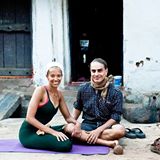Book now
Mysore style astanga self-practice
Mon-Fri 6.15-9am (last entry 7.30am)
Sat 7.30am start (led class last Saturday of each month)
Led Classes
Monday 6pm, Wednesday 6pm & Thursday evenings 7.30pm
Friday evenings 6pm
Follow the energy
A weekend of workshops with Petri Räisänen and Wambui Njuguna
 Petri Räisänen and his wife Wambui Njuguna are internationally recognised Astanga teachers — with a busy travel schedule, three yoga centres in Helsinki, books in publication, not to mention the important role of being parents!
Petri Räisänen and his wife Wambui Njuguna are internationally recognised Astanga teachers — with a busy travel schedule, three yoga centres in Helsinki, books in publication, not to mention the important role of being parents!
Today we are writing about our latest Mysore practice and workshops with them via the great Yoga Campus team in London. So we hope this blog piques your interest a little because their teaching is a truly wonderful thing to experience.
The description of Petri’s teaching that rings true, and also a reflection of Wambui’s wonderful adjustments, is as follows on the website: “[The] yoga pose adjustments are gentle, therapeutic and according to some, almost magical, and originate (besides his own practice and teaching) from his past work as a traditional Finnish folk healer and naturopath. His friendly, relaxed behaviour and intuitive perception give an open, energetic and meditative atmosphere to his classes.”
Some of you will practise led classes currently, and others will do self-practice. You notice the difference that you feel after practice but how often do we think about this and instead how often do we focus on increased flexibility? Petri reminds us about Brahmacharya, which Pattabhi Jois described as “we sense the energy and we follow the energy.” 
Focusing on flexibility is meaningless. Through our asana practice we create space in the body for the energy or ‘prana’ to flow. Yoga is therapeutic and all of us, as practitioners, come to “fix ourselves” rather than expecting someone else to do this for us.
Breath, asanas, bandhas and gazepoint are important. And details of the Astanga yoga method have actually changed over the years. For example, since Petri interviewed Pattabhi Jois (now deceased) in detail for his book about the Primary Series, the gazepoint towards the ‘third eye’ area of between the eyebrows has been replaced with the tip of the nose. However behind the structure of the asanas lies the real intention –energy – and this can only start to be understood via “1% theory, 99% practice.”
This is also important because, as Petri explains, “it is easy to feel sorry, or even shame, when we can’t achieve an asana”. This has become increasingly common because in Mysore and in studios all over the world there is now increased focus by people on hyper-flexibility. Much more so than the early days in the 19070s-1990s. Astanga yoga can even attract people who are naturally more flexible than the average person, and we tend to compare ourselves. He says, “It’s all yoga! Focus on softness and lightness and try to relieve pain and tension in the body.”
He also explains that we have to be smart when we practise. Occasionally we have to take risks to try something new but it is not about rushing and thinking about tomorrow or pushing ahead too fast. Often it’s the moment that we think “wow, my practice is good at the moment” that we then lose the focus and become injured! Focusing on this one practice, right here and now, is all we can and should do.
One of the workshops was a fascinating exploration of using energy to guide adjustments. He also explained a number of corrections to enable increased relaxation in asanas, with some fascinating insights.
This YouTube clip gives a great insight to Petri’s style.
Mon-Fri 6.15-9am (last entry 7.30am)
Sat 7.30am start (led class last Saturday of each month)
Monday 6pm, Wednesday 6pm & Thursday evenings 7.30pm
Friday evenings 6pm